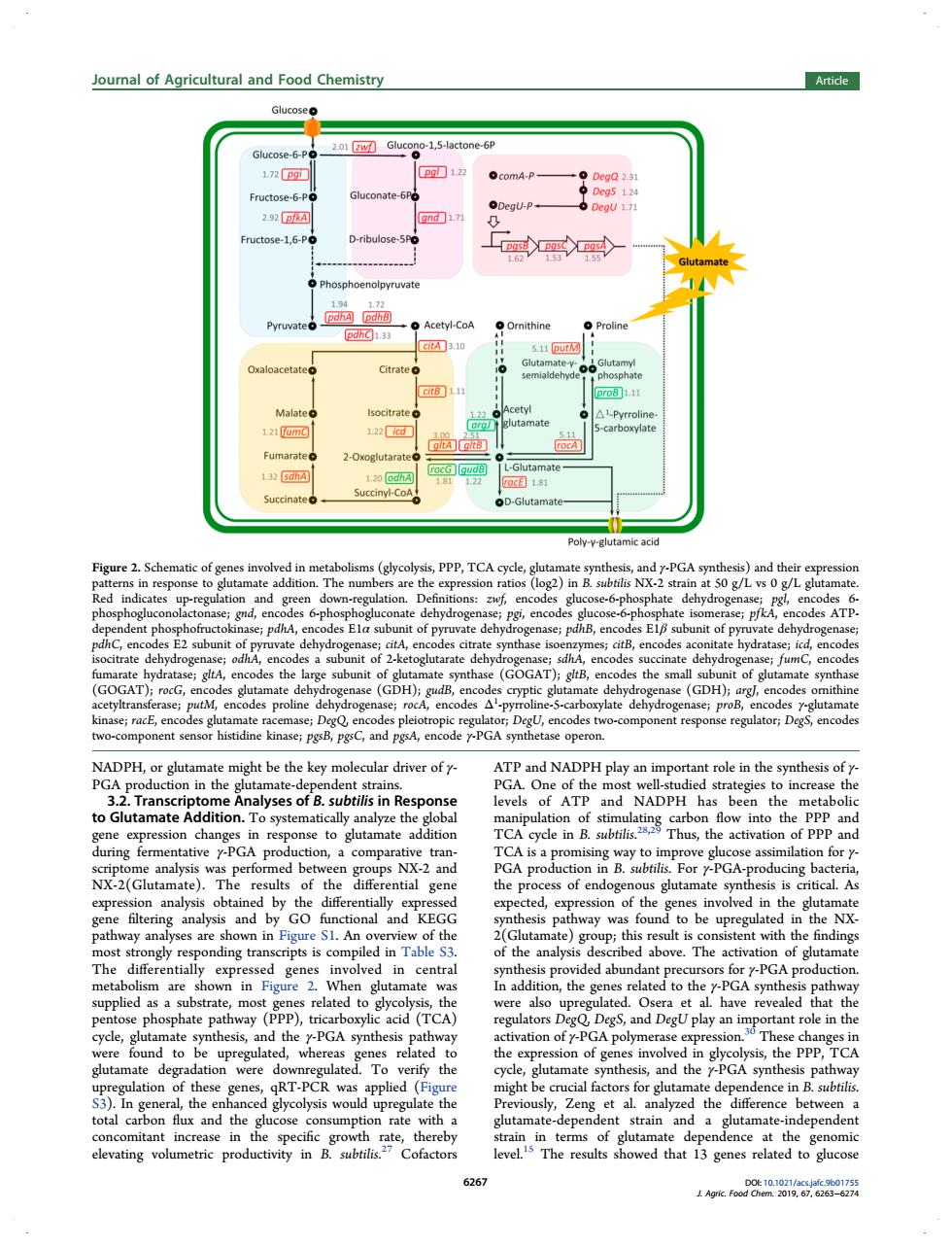正在加载图片...

Journal of Agricultural and Food Chemistry 1,5-lactone-6 Glucose 122 comA-P Fructose-6- 2 17 Fructose-1,5-P D-nbulose- L◆→ Acetyl-CoA 22 re 2 PPP.TC DH) nent respe ht be the key mo ular dnv of y n role in th ransc lyses o n NADPE DD to Thus,th a p K-2(Glu in Tab the analy The activat s pro the nt ro the asid (T et have the -PGA svnthesis tion of y-PGA T thes RT-PCR gh dependen y in e results showed that 13 genes related to glucose 626NADPH, or glutamate might be the key molecular driver of γ- PGA production in the glutamate-dependent strains. 3.2. Transcriptome Analyses of B. subtilis in Response to Glutamate Addition. To systematically analyze the global gene expression changes in response to glutamate addition during fermentative γ-PGA production, a comparative transcriptome analysis was performed between groups NX-2 and NX-2(Glutamate). The results of the differential gene expression analysis obtained by the differentially expressed gene filtering analysis and by GO functional and KEGG pathway analyses are shown in Figure S1. An overview of the most strongly responding transcripts is compiled in Table S3. The differentially expressed genes involved in central metabolism are shown in Figure 2. When glutamate was supplied as a substrate, most genes related to glycolysis, the pentose phosphate pathway (PPP), tricarboxylic acid (TCA) cycle, glutamate synthesis, and the γ-PGA synthesis pathway were found to be upregulated, whereas genes related to glutamate degradation were downregulated. To verify the upregulation of these genes, qRT-PCR was applied (Figure S3). In general, the enhanced glycolysis would upregulate the total carbon flux and the glucose consumption rate with a concomitant increase in the specific growth rate, thereby elevating volumetric productivity in B. subtilis. 27 Cofactors ATP and NADPH play an important role in the synthesis of γ- PGA. One of the most well-studied strategies to increase the levels of ATP and NADPH has been the metabolic manipulation of stimulating carbon flow into the PPP and TCA cycle in B. subtilis. 28,29 Thus, the activation of PPP and TCA is a promising way to improve glucose assimilation for γ- PGA production in B. subtilis. For γ-PGA-producing bacteria, the process of endogenous glutamate synthesis is critical. As expected, expression of the genes involved in the glutamate synthesis pathway was found to be upregulated in the NX- 2(Glutamate) group; this result is consistent with the findings of the analysis described above. The activation of glutamate synthesis provided abundant precursors for γ-PGA production. In addition, the genes related to the γ-PGA synthesis pathway were also upregulated. Osera et al. have revealed that the regulators DegQ, DegS, and DegU play an important role in the activation of γ-PGA polymerase expression.30 These changes in the expression of genes involved in glycolysis, the PPP, TCA cycle, glutamate synthesis, and the γ-PGA synthesis pathway might be crucial factors for glutamate dependence in B. subtilis. Previously, Zeng et al. analyzed the difference between a glutamate-dependent strain and a glutamate-independent strain in terms of glutamate dependence at the genomic level.15 The results showed that 13 genes related to glucose Figure 2. Schematic of genes involved in metabolisms (glycolysis, PPP, TCA cycle, glutamate synthesis, and γ-PGA synthesis) and their expression patterns in response to glutamate addition. The numbers are the expression ratios (log2) in B. subtilis NX-2 strain at 50 g/L vs 0 g/L glutamate. Red indicates up-regulation and green down-regulation. Definitions: zwf, encodes glucose-6-phosphate dehydrogenase; pgl, encodes 6- phosphogluconolactonase; gnd, encodes 6-phosphogluconate dehydrogenase; pgi, encodes glucose-6-phosphate isomerase; pfkA, encodes ATPdependent phosphofructokinase; pdhA, encodes E1α subunit of pyruvate dehydrogenase; pdhB, encodes E1β subunit of pyruvate dehydrogenase; pdhC, encodes E2 subunit of pyruvate dehydrogenase; citA, encodes citrate synthase isoenzymes; citB, encodes aconitate hydratase; icd, encodes isocitrate dehydrogenase; odhA, encodes a subunit of 2-ketoglutarate dehydrogenase; sdhA, encodes succinate dehydrogenase; fumC, encodes fumarate hydratase; gltA, encodes the large subunit of glutamate synthase (GOGAT); gltB, encodes the small subunit of glutamate synthase (GOGAT); rocG, encodes glutamate dehydrogenase (GDH); gudB, encodes cryptic glutamate dehydrogenase (GDH); argJ, encodes ornithine acetyltransferase; putM, encodes proline dehydrogenase; rocA, encodes Δ1 -pyrroline-5-carboxylate dehydrogenase; proB, encodes γ-glutamate kinase; racE, encodes glutamate racemase; DegQ, encodes pleiotropic regulator; DegU, encodes two-component response regulator; DegS, encodes two-component sensor histidine kinase; pgsB, pgsC, and pgsA, encode γ-PGA synthetase operon. Journal of Agricultural and Food Chemistry Article DOI: 10.1021/acs.jafc.9b01755 J. Agric. Food Chem. 2019, 67, 6263−6274 6267